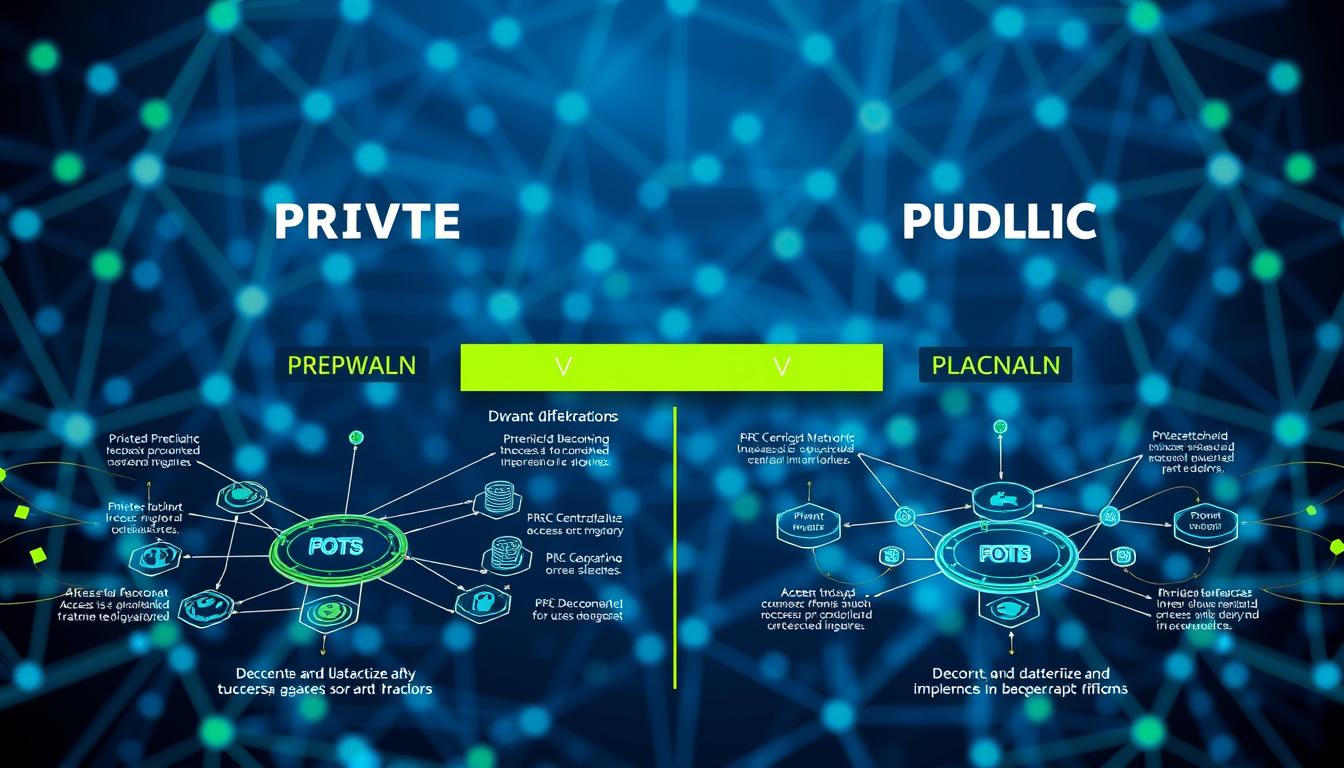Now Reading: Private vs public blockchain networks advantages and disadvantages explained
- 01
Private vs public blockchain networks advantages and disadvantages explained
Private vs public blockchain networks advantages and disadvantages explained

Modern digital infrastructure relies on secure data management solutions that balance accessibility with control. Distributed ledger systems have emerged as transformative tools, evolving far beyond their initial financial applications. These systems now power innovations across industries through their unique combination of shared visibility and tamper-resistant record-keeping.
Since their debut in 2009, these technologies have developed sophisticated architectures that support diverse organizational needs. Contemporary implementations often feature flexible participation models and advanced consensus mechanisms, enabling tailored solutions for different operational requirements.
Choosing the right ledger configuration impacts everything from audit compliance to partnership ecosystems. Businesses must consider multiple factors including information access policies, validation processes, and governance frameworks. Healthcare providers, financial institutions, and logistics companies increasingly adopt these systems to streamline operations while maintaining strict data integrity standards.
The decision between restricted and open-access platforms influences long-term strategic positioning. Organizations evaluate options based on regulatory environments, scalability demands, and partnership dynamics. This choice ultimately determines how effectively companies leverage distributed record-keeping to drive innovation and maintain competitive advantage.
Understanding Blockchain Fundamentals
At its core, blockchain technology reshapes how information is shared and secured across digital platforms. This system operates as a distributed ledger that synchronizes records across multiple computers. Each participant maintains an identical copy of the database, creating transparency while preventing unauthorized changes.
Blockchain Definition and Core Concepts
A blockchain structures data into interconnected blocks containing transaction details and timestamps. Every new entry links to prior records through cryptographic hashes, forming an unbreakable chain. Digital signatures validate each action, ensuring only authorized users can modify information.
Key Components and Decentralization
The technology relies on nodes – individual devices that store and verify the entire ledger. These nodes collaborate through consensus protocols like Proof of Work to agree on valid transactions. This setup removes central authorities, allowing direct peer-to-peer interactions without intermediaries.
Each block contains three essential elements: transaction data, a unique hash code, and the previous block’s fingerprint. This design creates an immutable timeline of events that becomes more secure as the chain grows longer. Network participants automatically reject altered records since they break the cryptographic sequence.
Private Blockchain Overview
Enterprise data management demands solutions balancing transparency with restricted visibility. Permissioned ledgers governed by a single entity address this need through tailored participation rules. These systems enable selective collaboration while maintaining centralized oversight for critical operations.

Advantages of Permissioned Ledgers
Restricted-entry systems deliver three primary benefits for business environments:
- Accelerated throughput: Fewer validation nodes enable faster transaction confirmations compared to open networks
- Custom governance: Operators define participation criteria and data visibility levels
- Regulatory alignment: Built-in compliance features meet industry-specific requirements
Healthcare providers use these systems to share patient records securely across institutions. Financial firms leverage them for interbank settlements with adjustable transaction privacy. Multi-tiered access protocols allow different clearance levels within the same network.
Administrators maintain authority to modify historical records when necessary – a critical feature for error correction. This control mechanism supports audit trails while preserving data accuracy. Custom consensus rules further optimize performance for specialized use cases.
These permissioned environments prove ideal for organizations handling proprietary information or operating under strict compliance mandates. They combine blockchain’s traceability with traditional database management features.
Public Blockchain Overview
Open-access distributed ledgers redefine collaboration in the digital age. Public blockchains operate as decentralized systems where anyone can join without approvals or identity checks. These networks replace institutional gatekeepers with community-driven validation, creating transparent ecosystems for global participation.

Core Attributes of Public Blockchains
Permissionless architecture ensures equal access for all users. Transactions become immutable once added to the chain, protected by cryptographic hashing and decentralized consensus. This setup guarantees data integrity without relying on trusted third parties.
Economic incentives drive network security through token rewards and transaction fees. Miners and validators contribute computing power to maintain the system, earning digital assets for their efforts. Pseudo-anonymity preserves user privacy while maintaining full transaction visibility.
Platforms like Bitcoin showcase public blockchain’s ability to enable borderless payments. Ethereum extends functionality with programmable smart contracts accessible to anyone online. These systems demonstrate how open participation models foster innovation at internet scale.
Exploring Permissioned and Consortium Networks
Collaborative business ecosystems require systems that balance openness with structured governance. Hybrid ledger models merge the best features of restricted and open networks, creating adaptable frameworks for multi-party operations. These solutions enable verified participants to interact securely while maintaining clear control over data flows.

Permissioned blockchain networks operate like gated communities. Users gain access after identity checks but face activity limits based on assigned roles. Unlike closed systems, transaction records remain visible to all approved participants. This setup ensures transparency while preventing unauthorized actions through smart contract-enforced rules.
Consortium models take collaboration further by distributing authority among trusted organizations. Groups like banking alliances or supply chain partners jointly manage validation processes and protocol updates. Decisions require majority approval, preventing single-entity dominance while streamlining cross-company workflows.
| Feature | Permissioned Blockchains | Consortium Networks |
|---|---|---|
| Governance | Central authority manages access | Predefined group shares control |
| Data Visibility | Public within network | Shared among members |
| Use Cases | Regulated industries | Cross-company operations |
These hybrid systems excel in scenarios requiring auditable collaboration. Shipping conglomerates use consortium blockchains to track international cargo, while healthcare consortia securely share patient data across providers. The models reduce disputes through immutable records and automate compliance via customizable smart contracts.
By blending selective participation with decentralized validation, these networks address gaps in traditional approaches. They deliver the auditability of open ledgers with the efficiency of closed systems, making them ideal for complex partnerships.
Private vs public blockchain networks advantages and disadvantages explained
Organizations face critical choices when implementing distributed ledger systems. The selection between restricted and open architectures directly affects operational efficiency, security, and partnership potential. This comparison of ledger types reveals distinct operational profiles suited for different business needs.
Strengths of Permissioned Networks
Restricted-access systems excel in environments demanding rapid processing and tight data governance. Transaction speeds often surpass those of open networks due to fewer validation nodes. Customizable rules let operators enforce role-based permissions and compliance protocols.
Healthcare providers leverage these systems for cross-institution patient data sharing. Financial institutions use them to process confidential transactions without exposing sensitive details. Centralized oversight enables quick error correction while maintaining audit trails.
Challenges in Open Networks
Decentralized platforms face hurdles when handling high-volume enterprise operations. Network congestion can slow transaction confirmations during peak usage. Transparent record-keeping creates potential exposure risks for sensitive commercial activities.
| Feature | Permissioned Networks | Open Networks |
|---|---|---|
| Speed | 1,000+ TPS | 3-30 TPS |
| Access Control | Role-based permissions | Unrestricted |
| Compliance | Built-in tools | Limited options |
| Scalability | Enterprise-ready | Layer-2 solutions needed |
Energy companies use permissioned systems for real-time supply chain tracking. Meanwhile, global payment platforms rely on open networks for borderless transactions. Each model serves distinct purposes based on security needs and collaboration requirements.
Control, Access and Identity Management
Digital trust frameworks require robust mechanisms to verify user identities while balancing transparency needs. Permissioned systems, as detailed in this comparison of ledger types, enable organizations to enforce granular access policies through integrated authentication tools.

Role of Identity in Blockchain Governance
Restricted networks excel at linking digital actions to real-world entities. Key features include:
- Custom integration: Compatibility with existing enterprise identity providers like Okta or Azure AD
- Selective disclosure: Users share specific credentials without exposing full profiles
- Audit-ready trails: Time-stamped verification records for compliance reporting
Healthcare consortia use these capabilities to share patient data across hospitals while maintaining HIPAA compliance. Each participant controls which lab results or treatment histories become visible to partners.
Open networks take contrasting approaches through self-managed cryptographic keys. Users operate pseudonymously, though third-party services now bridge this gap:
- Hardware wallets for secure key storage
- Decentralized identifiers (DIDs) for reusable credentials
- Zero-knowledge proofs to verify eligibility without exposing details
Financial institutions increasingly adopt hybrid models. They combine private chain control for internal operations with public network interoperability for customer transactions. This balances regulatory needs with innovation potential.
Consensus Mechanisms and Network Performance
The speed and reliability of digital systems hinge on their underlying agreement protocols. These protocols determine how quickly nodes validate entries and update shared records. Different approaches balance speed with security, creating trade-offs for various operational needs.
Impact of Consensus on Latency
Validation methods directly affect how fast networks confirm actions. Proof of Work (PoW) requires intensive computations, causing delays in large systems. Smaller groups using Practical Byzantine Fault Tolerance (PBFT) achieve near-instant validation through pre-approved nodes.
Open networks face geographical challenges as participants span multiple time zones. Data packets travel through numerous routers, adding milliseconds at each hop. Clusters of well-connected nodes form naturally to reduce these delays, prioritizing frequent collaborators.
Efficient Transaction Processing
Restricted networks excel at rapid processing through optimized protocols. Known participants enable trust-based shortcuts that skip redundant checks. A 10-node healthcare consortium might confirm entries in 0.3 seconds versus 10 minutes on open platforms.
| Consensus Type | Avg. Latency | Throughput Capacity |
|---|---|---|
| Proof of Work | 10+ minutes | 7 TPS |
| Proof of Stake | 5-30 seconds | 1,000 TPS |
| PBFT | <1 second | 5,000 TPS |
Emerging hybrid models combine multiple protocols to address limitations. Layer-2 solutions batch process off-chain actions before finalizing them collectively. These innovations help balance decentralization demands with commercial speed requirements.
Security and Compliance Considerations
Digital trust foundations demand robust safeguards for sensitive operations. Effective systems combine advanced protective measures with adaptable governance frameworks to meet evolving threats.
Data Integrity and Cryptography
Modern cryptographic techniques form the backbone of secure data management. Hash functions and digital signatures create tamper-evident records across distributed systems. These tools ensure information remains unchanged unless authorized through multi-party verification.
Permissioned environments like private blockchain setups enhance protection through layered encryption. Enterprises control access points while maintaining full audit trails. Such configurations meet strict security requirements for industries handling financial or medical records.
Regulatory Compliance Insights
Navigating legal landscapes requires built-in adherence tools. Automated monitoring systems track transactions against regional regulations in real time. This proactive approach reduces compliance gaps during cross-border operations.
Many business platforms now integrate customizable rule engines. These tools adjust validation parameters as policies evolve. Hybrid models balance transparency requirements with competitive confidentiality needs, particularly in regulated sectors using private blockchain solutions.
FAQ
How do enterprise-grade solutions differ between restricted and open ledgers?
Enterprise systems often prioritize controlled access, compliance, and transaction efficiency. Restricted chains allow organizations to manage permissions, enforce governance policies, and optimize performance for specific workflows. Open ledgers prioritize decentralization but may lack customization for regulated industries.
What industries benefit most from permissioned ledger systems?
Sectors like finance, healthcare, and supply chain management favor permissioned systems due to strict data privacy requirements. These networks enable secure sharing of sensitive information while meeting regulations like GDPR or HIPAA through granular access controls.
Why do some organizations avoid decentralized public ledgers?
While offering transparency, fully decentralized systems face challenges with throughput limitations and pseudonymous transactions. Businesses requiring real-time auditing, predictable latency, or KYC compliance often find closed networks better suited to their operational needs.
How does cryptography ensure data integrity across different ledger types?
Both models use cryptographic hashing to secure transaction records. Private chains often implement additional encryption layers for confidential data, while public networks rely on proof-of-work or stake mechanisms to validate entries without centralized oversight.
Can hybrid models combine aspects of both ledger architectures?
Consortium chains demonstrate this balance, allowing multiple trusted entities to share validation rights. These semi-decentralized systems maintain auditability while improving scalability compared to fully public networks, making them popular in banking collaborations.
What role do smart contracts play in optimizing business processes?
Automated agreements streamline operations across both network types. Private implementations enable customized contract terms with faster execution, while public chains provide tamper-proof enforcement at the cost of higher latency in some cases.














